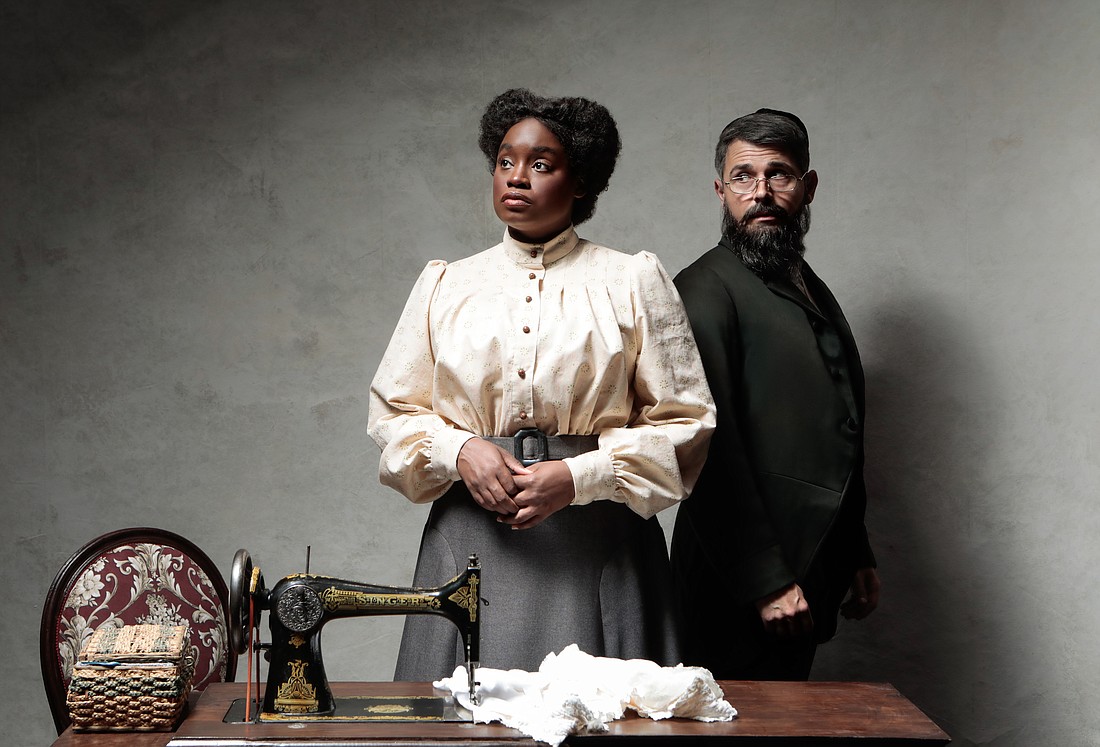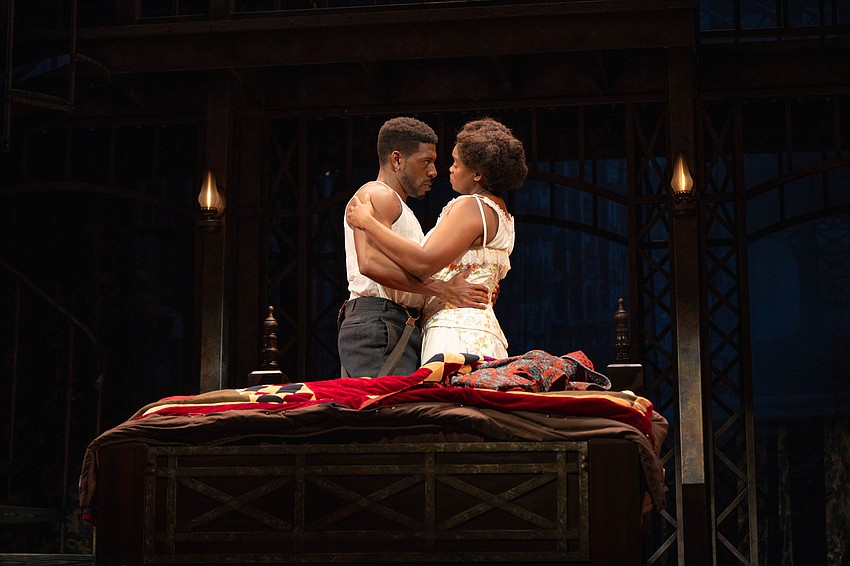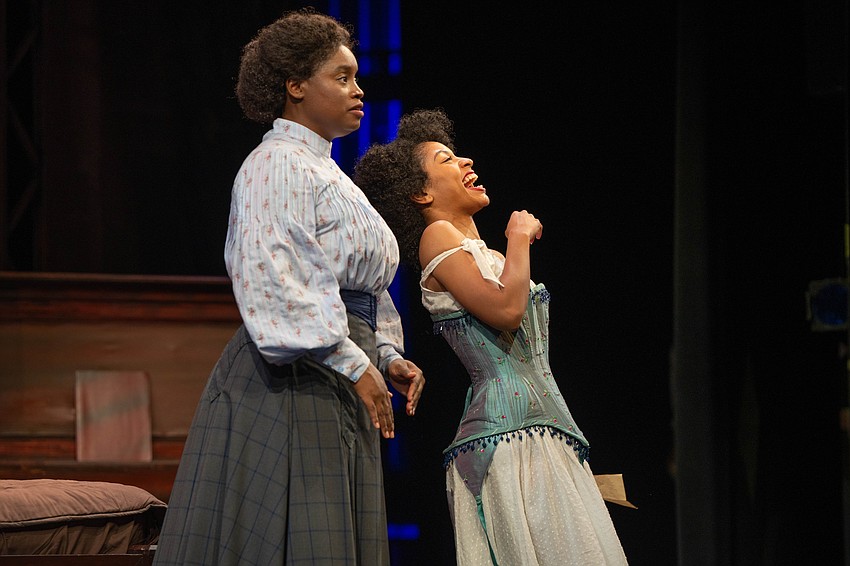- May 21, 2025
-
-
Loading

Loading

Clothes make the man, but they also make the woman. Lynn Nottage’s “Intimate Apparel” is about a woman who makes the clothes. She’s one of many threads in this ambitious Asolo Rep production.
That woman’s name is Esther (Aneisa J. Hicks). And she’s an African-American woman. That’s hard enough in 2024. In 1905, it was harder, but Esther keeps on keeping on. She makes a living as a freelance tailor. She’s damn good at it. You name it, Esther can sew it. (Naughty negligees are her specialty.)
Although Esther’s skillful and strong, she’s not an island unto herself. She gets by with a little help from her New York City friends. These include Mr. Marks (Sasha Andreev), a Jewish merchant who sells Esther pretty fabrics and makes her heart flutter (her love is unrequited); Mrs. Van Buren (Adelin Phelps), an upper-class matron who's superficially shunned by high society as a social climber; Mayme (Trezure B Coles), a sex worker who loves her job; George (Curtis Bannister), a hardworking immigrant from Barbados with Horatio Alger ambitions (he’s Esther’s Mr. Wrong); and Mrs. Dickson (Regina Marie Williams), the boarding house landlady whose loyalty to her tenants isn’t just about the rent.
While “Intimate Apparel” is mainly a character study, Nottage also aims her magnifying glass at American society. It’s 1905, the era of Doctorow’s “Ragtime,” and the extreme close-up isn’t pretty. Our nation had a rigid social hierarchy back then. It pigeonholed each individual by race, income, religion, ethnic origin, status and gender.
The “right” people at the top knew their station in life; the lower orders also knew their place. In Nottage’s play, her characters’ authentic selves don’t really fit inside their tight, little boxes. But they try, and it hurts. (That’s the play’s subtext, not a blunt point.) Society’s just background. The people are the point.
Garments (both inner and outer) provide the high-powered lens of Nottage’s social criticism. What you wear says a lot about who you are — or try to be.

Nottage knows that clothes speak wordless volumes about their wearers and their world. It’s brilliant theatrical shorthand.
Director Austene Van keeps it simple and sincere, with no flashy, stagey gimmicks. “What you see is what you get” is her directorial style.
That’s in synch with Nottage’s focus. “Intimate Apparel” is about what’s under the skin, not surface appearances. Van stays faithful to that naked (or barely naked) truth.
Asolo Rep’s backstage talents give visible/audible form to this truth. Voice coach Patricia Delorey does outstanding work with the music of Nottage’s dialogue and dialects.
Matthew J. LeFebvre’s costumes are a tour de force. Esther’s character is a ninja with a sewing needle. LeFebvre’s creations sell you on her genius — and that takes a spark of his own. Michael Hoover’s two-tier set works like a smart reversible jacket. Flip it one way, it’s a bedroom. Flip it the other way, it’s a shop. Nice.
These clever talents all serve Nottage’s world-building, And that serves her story and characters. Her story has a well-woven plot — with a few loose threads, a plot-hole or two and one predictable twist.
Esther’s money-in-the-mattress is a locked-and-loaded Checkovian shotgun. Once you see it, you instantly see what’s coming. I figure the playwright knows that. It’s still frustrating that her smart characters don’t. A minor gripe.
Characterization is clearly this playwright’s strong point. Nottage’s people are sharply defined in her script. The Asolo Rep actors bring that clarity to the stage. Lesser talents might stumble into stereotype. They don’t.

Andreev’s Mr. Marks wears the mind-forged manacles of his repressive Orthodox belief system. He wears black; he keeps his distance. But Mr. Marks’ libido sneaks out when he isn’t paying attention. (When he and Esther caress those shiny, silky fabrics, it’s downright erotic.)
Coles’ Mayme has a heart, though it isn’t made of gold. Bannister’s George didn’t set out to be a bad man; he wanted to be a better man. Despite all evidence to the contrary, he’s a true believer in the American dream.
Williams’ level-headed Mrs. Dickinson is the cool captain of her New York City boarding house: a Kathryn Janeway for the Gilded Age. Phelps’ Mrs. Van Buren is shunned by swells as a gold digger who slept her way to the top. The truth is, she’s holding on by her fingernails — and it’s a long way down. Phelps’ character is also more than she seems.
Great performances all around. But Hicks’ Esther hits it out of the park. Her character’s a good person, but no plaster saint. Hicks portrays her as a flesh-and-blood, 30-something woman with romantic passions and a desire for financial security.
But love and money aren’t her deepest heart’s desires. At the core of her being, Esther’s an artist. One who paints with needle and thread. Life puts her through the wringer. When Esther comes out the other side, she’s still standing. She’s lost a lot. But she doesn’t lose her artistic soul.
Hicks’ touching performance lets you know how that triumph feels.